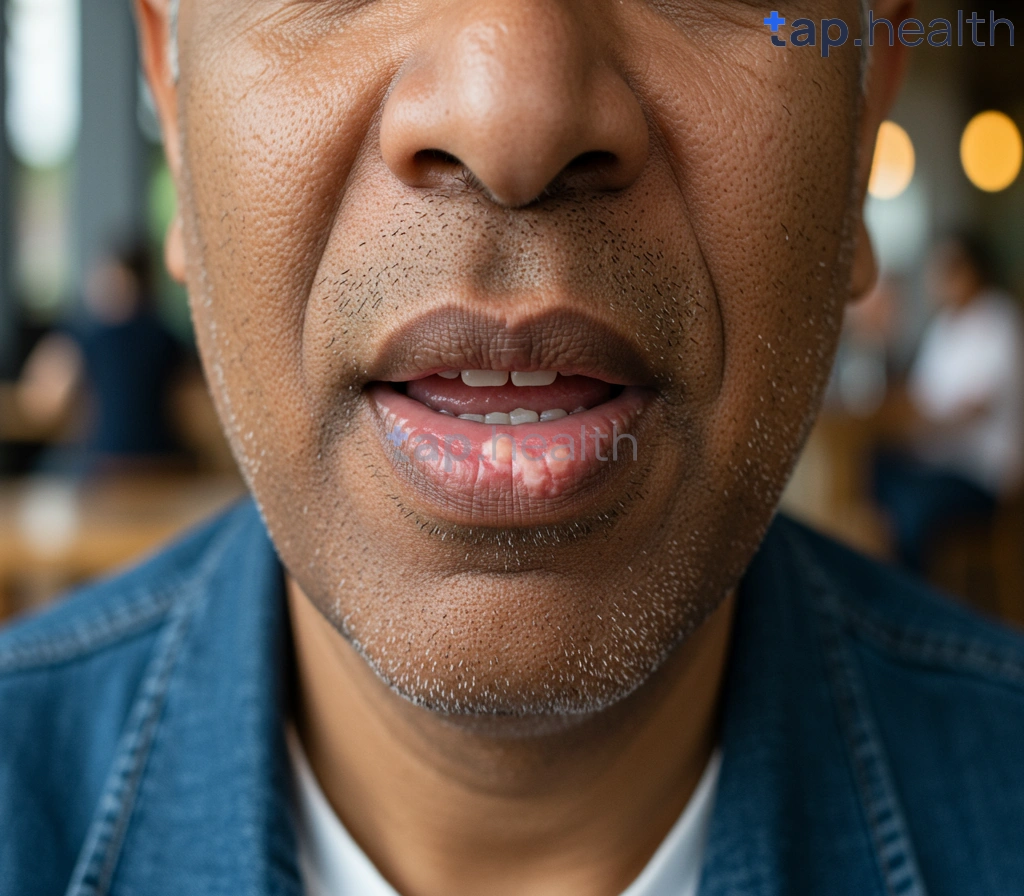Table of Contents
- Oral Thrush and Diabetes: A Comprehensive Guide
- Understanding Oral Thrush Symptoms in Diabetics
- Risk Factors for Oral Thrush in People with Diabetes
- How to Prevent Oral Thrush if You Have Diabetes
- Oral Thrush Treatment for People with Diabetes
- Frequently Asked Questions
- References
Living with diabetes requires careful management, and understanding potential complications is crucial for maintaining your health. One such complication, often overlooked, is oral thrush. This blog post will delve into the connection between diabetes and oral thrush, exploring the symptoms you should watch out for and the risk factors that increase your susceptibility. We’ll provide clear, easy-to-understand information to help you better understand Oral Thrush in People with Diabetes: Understanding Symptoms and Risk Factors and empower you to take proactive steps towards prevention and treatment. Let’s get started!
Oral Thrush and Diabetes: A Comprehensive Guide
Oral thrush, a fungal infection of the mouth, is more common in individuals with diabetes. High blood sugar levels create an environment conducive to fungal growth, making people with diabetes significantly more susceptible. This increased vulnerability highlights the importance of proactive oral hygiene and regular medical check-ups. Understanding the symptoms and risk factors is crucial for early detection and effective management.
Recognizing the Symptoms of Oral Thrush
Oral thrush manifests as creamy white lesions or patches on the tongue, inner cheeks, gums, or throat. These lesions can be painful and may bleed if scraped. Other symptoms include a burning sensation in the mouth, difficulty swallowing, and a change in taste. It’s vital to note that these symptoms can also be indicative of other oral health problems, so consulting a doctor is essential for accurate diagnosis.
Risk Factors for Oral Thrush in Diabetics
Several factors increase the risk of developing oral thrush in individuals with diabetes. Poorly controlled blood sugar levels are a primary contributor, as high glucose levels weaken the immune system, making individuals more vulnerable to infections. Other factors include weakened immune systems due to other health conditions, the use of certain medications (like steroids), and poor oral hygiene. The warm, humid climate prevalent in many Indian and tropical countries further exacerbates the risk of fungal growth.
Prevention and Management
Maintaining good oral hygiene is paramount. Regular brushing and flossing, along with the use of an antifungal mouthwash as recommended by a doctor, can significantly reduce the risk of oral thrush. Strict blood sugar control is also crucial. For those with diabetes, regular check-ups with both a doctor and dentist are vital for early detection and appropriate treatment. Remember that while nearly 15% of diabetics experience foot ulcers in their lifetime, with high amputation risks, maintaining overall health, including oral health, is equally critical in preventing serious complications. Consult your doctor or dentist immediately if you experience any of the symptoms mentioned above. The importance of this cannot be overstated, as highlighted in our article on Why Oral Health Matters for Diabetic Patients. Managing diabetes effectively is crucial, and planning ahead, especially when traveling, can help you maintain control. For helpful advice, see our guide on Traveling with Diabetes: Essential Tips for a Safe & Healthy Journey.
Understanding Oral Thrush Symptoms in Diabetics
Oral thrush, a fungal infection caused by *Candida albicans*, is more common in individuals with diabetes. High blood sugar levels create a favorable environment for *Candida* to thrive, leading to increased susceptibility. In tropical and Indian climates, where humidity and heat are prevalent, the risk of developing oral thrush can be even higher. This is further complicated by the fact that a significant portion of the diabetic population – 30-50% – experiences diabetic neuropathy. This condition, characterized by nerve damage, often results in reduced sensation in the mouth, potentially delaying diagnosis and treatment of oral thrush.
Recognizing the Symptoms
Early detection is crucial. Symptoms of oral thrush in diabetics can include creamy white lesions or patches on the tongue, inner cheeks, gums, or throat. These lesions may be painful or cause a burning sensation, particularly when eating spicy or acidic foods – a common feature of many Indian cuisines. Some individuals may also experience dryness in the mouth, a change in taste, or difficulty swallowing. It’s important to note that these symptoms can sometimes be subtle, especially in those with reduced sensation due to neuropathy. If you experience any of these symptoms and have diabetes, consult a doctor immediately.
Managing Oral Thrush
Prompt treatment is vital to prevent complications. Your doctor may prescribe antifungal medications, such as nystatin or fluconazole, to clear the infection. Maintaining good blood sugar control is also critical in preventing recurrence. This includes following your prescribed diabetes management plan, which may include medication, diet, and regular exercise. Practicing diligent oral hygiene, including gentle brushing and flossing, helps create a less hospitable environment for *Candida*. In regions like India, where access to healthcare can vary, prompt consultation with a qualified medical professional is especially important. Don’t delay seeking medical attention if you suspect you have oral thrush. Managing blood sugar levels effectively is key, and choices like Can a Diabetic Chew Gum? Health Risks and Benefits become important considerations. Furthermore, understanding hydration is crucial, so knowing Can Diabetic Patients Drink ORS Safely? can be beneficial.
Risk Factors for Oral Thrush in People with Diabetes
Oral thrush, a fungal infection caused by Candida albicans, is more common in individuals with diabetes. Several factors contribute to this increased susceptibility, particularly prevalent in Indian and tropical countries with their unique climatic conditions and lifestyles. High blood sugar levels are a primary risk factor. Uncontrolled diabetes creates an environment ripe for fungal overgrowth, as Candida thrives on glucose. Poorly managed diabetes, characterized by hyperglycemia, weakens the immune system, further increasing vulnerability to infections like oral thrush.
Weakened Immunity & Oral Hygiene
Beyond blood sugar control, compromised immune function plays a significant role. This can stem from poorly controlled diabetes itself or from other underlying health conditions. Poor oral hygiene, including infrequent brushing and flossing, allows Candida to accumulate, leading to infection. This is particularly important in hot and humid climates common in many Indian and tropical regions, where conditions may exacerbate the growth of the fungus. The use of corticosteroids or other immunosuppressant medications, frequently prescribed for various health issues, can further diminish the body’s ability to fight off oral thrush.
Lifestyle and Dietary Factors
Lifestyle choices also influence the risk. A diet high in refined sugars and processed foods provides an abundant food source for Candida. In many parts of India and tropical countries, traditional diets may contain high sugar content, which necessitates careful consideration. Dry mouth, a common side effect of certain medications and a symptom of some diabetes complications, also contributes to the risk. The warm, humid climate in these regions can exacerbate this risk. Finally, the research demonstrating a sevenfold increased risk of Type 2 diabetes in children of mothers with gestational diabetes highlights the long-term consequences of poorly controlled blood sugar and the potential for increased susceptibility to oral thrush later in life. Maintaining good blood sugar control, practicing diligent oral hygiene, and adopting a balanced diet are crucial steps in preventing oral thrush. Consult your doctor or dentist for any concerns about oral thrush, particularly if you have diabetes. The impact of diabetes extends beyond oral health; to learn more about its effects on other systems, read our article on How Does Diabetes Affect the Respiratory System?. Diabetes can also affect various aspects of your overall well-being, such as hair health. For more information, check out our article on Does diabetes cause hair thinning: What You Need to Know.
How to Prevent Oral Thrush if You Have Diabetes
Oral thrush, a fungal infection of the mouth, is more common in people with diabetes due to their weakened immune systems and higher blood sugar levels. Maintaining good blood sugar control is crucial in preventing this uncomfortable condition. This is especially important in tropical and Indian climates where warm, humid conditions can foster fungal growth.
Managing Blood Sugar Levels
Effective blood sugar management is the cornerstone of oral thrush prevention. Regular monitoring of blood glucose levels, coupled with a balanced diet and regular exercise, is vital. Remember, up to 80% of Type 2 diabetes cases can be delayed or prevented through lifestyle changes, as highlighted by the Indian government. This underscores the significant impact lifestyle choices have on overall health and susceptibility to infections like oral thrush. For more tips on managing your diabetes effectively, check out our guide on 10 Proven Tips for Effective Diabetes Management.
Oral Hygiene Practices
Maintaining impeccable oral hygiene is paramount. Brush your teeth gently but thoroughly at least twice daily with a soft-bristled toothbrush, and floss daily to remove food particles that can contribute to fungal growth. Regular rinsing with an antiseptic mouthwash can also help reduce the risk of infection. In hotter, more humid regions like those prevalent in India and other tropical countries, increased vigilance in oral hygiene is particularly important.
Hydration and Diet
Staying well-hydrated helps maintain a healthy oral environment, washing away food debris and reducing the chances of fungal overgrowth. A balanced diet, low in refined sugars and high in fruits and vegetables, supports a strong immune system, further bolstering your body’s natural defenses against oral thrush. Consult with your doctor or a registered dietitian for personalized dietary advice tailored to your needs and location.
Regular Dental Checkups
Regular visits to your dentist are crucial for early detection and prevention of any oral health issues, including oral thrush. They can also provide guidance on specific oral hygiene strategies tailored to your individual needs and risk factors. Prompt treatment of any oral problems is essential to prevent complications.
Oral Thrush Treatment for People with Diabetes
Oral thrush, a fungal infection caused by Candida albicans, is more common in individuals with diabetes, especially in regions like India with high rates of early-onset diabetes. This is partly due to the higher blood sugar levels characteristic of diabetes, which creates a favorable environment for fungal growth. Managing blood sugar effectively is crucial in preventing and treating oral thrush. For people in India and other tropical countries, where warm and humid climates further support fungal growth, proactive measures are even more important.
Effective Treatment Options
Treatment typically involves antifungal medications. These can be topical, such as creams or gels applied directly to the affected areas, or systemic, taken orally or intravenously for more severe cases. Your doctor will determine the best course of action based on the severity of your infection and your overall health. Over-the-counter antifungal medications are available, but it’s essential to consult a healthcare professional for diagnosis and treatment, particularly given the higher risk in individuals with diabetes. Self-treating can delay proper care and potentially worsen the infection.
Lifestyle Modifications and Prevention
Maintaining good oral hygiene is vital. This includes regular brushing and flossing, and rinsing your mouth with an antifungal mouthwash, as recommended by your doctor. Since early-onset diabetes is prevalent among Indians aged 25-40, regular dental check-ups are strongly recommended for this age group, especially if you have diabetes. Controlling blood sugar levels through diet, exercise, and medication, as prescribed by your doctor, significantly reduces the risk of developing oral thrush. Staying hydrated also helps maintain a healthy oral environment. Remember that managing underlying conditions like diabetes is crucial, and you might find information on managing medication alongside diabetes helpful in Can Diabetics Take Oral Steroids?
Seeking Professional Help in India and Tropical Regions
If you experience symptoms like white patches in your mouth, difficulty swallowing, or soreness, seek immediate medical attention. Prompt diagnosis and treatment are key to preventing complications and improving your quality of life. Remember, early detection and management are crucial, especially considering the high prevalence of early-onset diabetes in India and other tropical countries. For further information on supporting your overall health while managing diabetes, you may find Safe and Effective Dietary Supplements for Diabetes Care insightful.
Frequently Asked Questions
Q1. What is oral thrush, and why are people with diabetes more susceptible?
Oral thrush is a fungal infection in the mouth. People with diabetes are more prone to it because high blood sugar levels create an environment where fungus can easily grow.
Q2. What are the common symptoms of oral thrush?
Common symptoms include creamy white lesions (patches) on the tongue or inner cheeks, a burning sensation in the mouth, and difficulty swallowing.
Q3. How can I prevent oral thrush if I have diabetes?
Maintain excellent oral hygiene (brush and floss regularly, use an antifungal mouthwash), control your blood sugar levels strictly as advised by your doctor, and see your doctor and dentist regularly for checkups.
Q4. What is the typical treatment for oral thrush?
Treatment usually involves antifungal medications prescribed by a doctor. It’s crucial to get a proper diagnosis and follow your doctor’s instructions.
Q5. Does living in a hot, humid climate increase my risk of oral thrush?
Yes, warm and humid climates, such as those found in India and other tropical regions, can increase your risk of developing oral thrush because fungus thrives in such conditions.
References
- A Practical Guide to Integrated Type 2 Diabetes Care: https://www.hse.ie/eng/services/list/2/primarycare/east-coast-diabetes-service/management-of-type-2-diabetes/diabetes-and-pregnancy/icgp-guide-to-integrated-type-2.pdf
- Diabetes Mellitus: Understanding the Disease, Its Diagnosis, and Management Strategies in Present Scenario: https://www.ajol.info/index.php/ajbr/article/view/283152/266731



